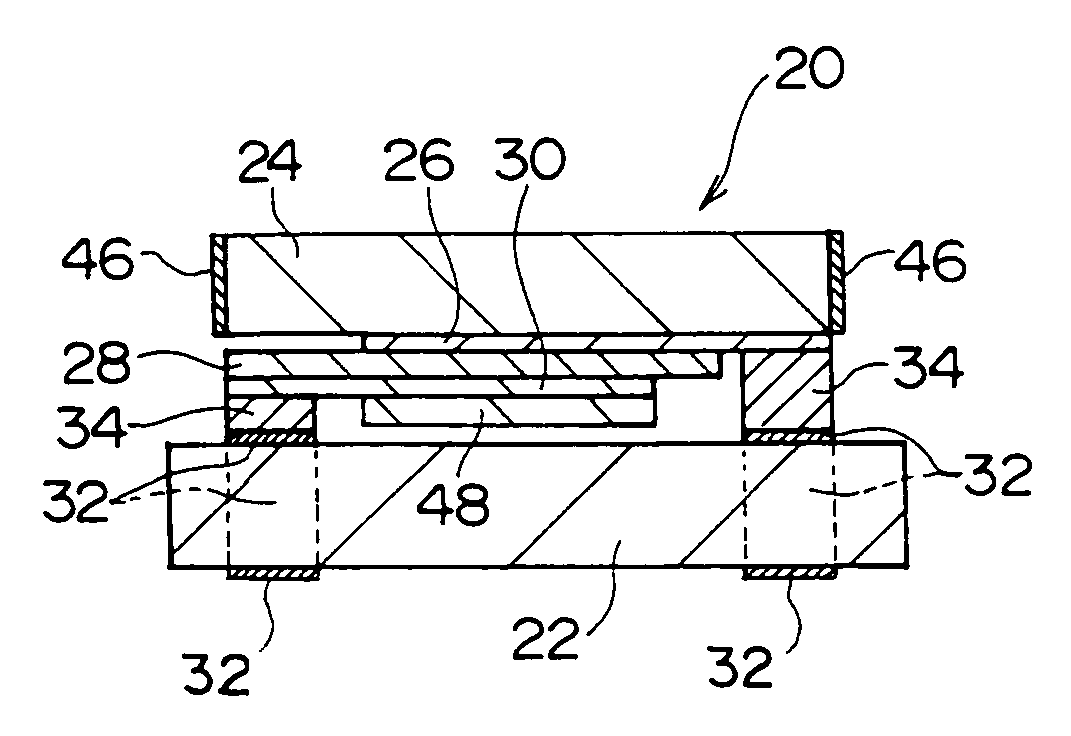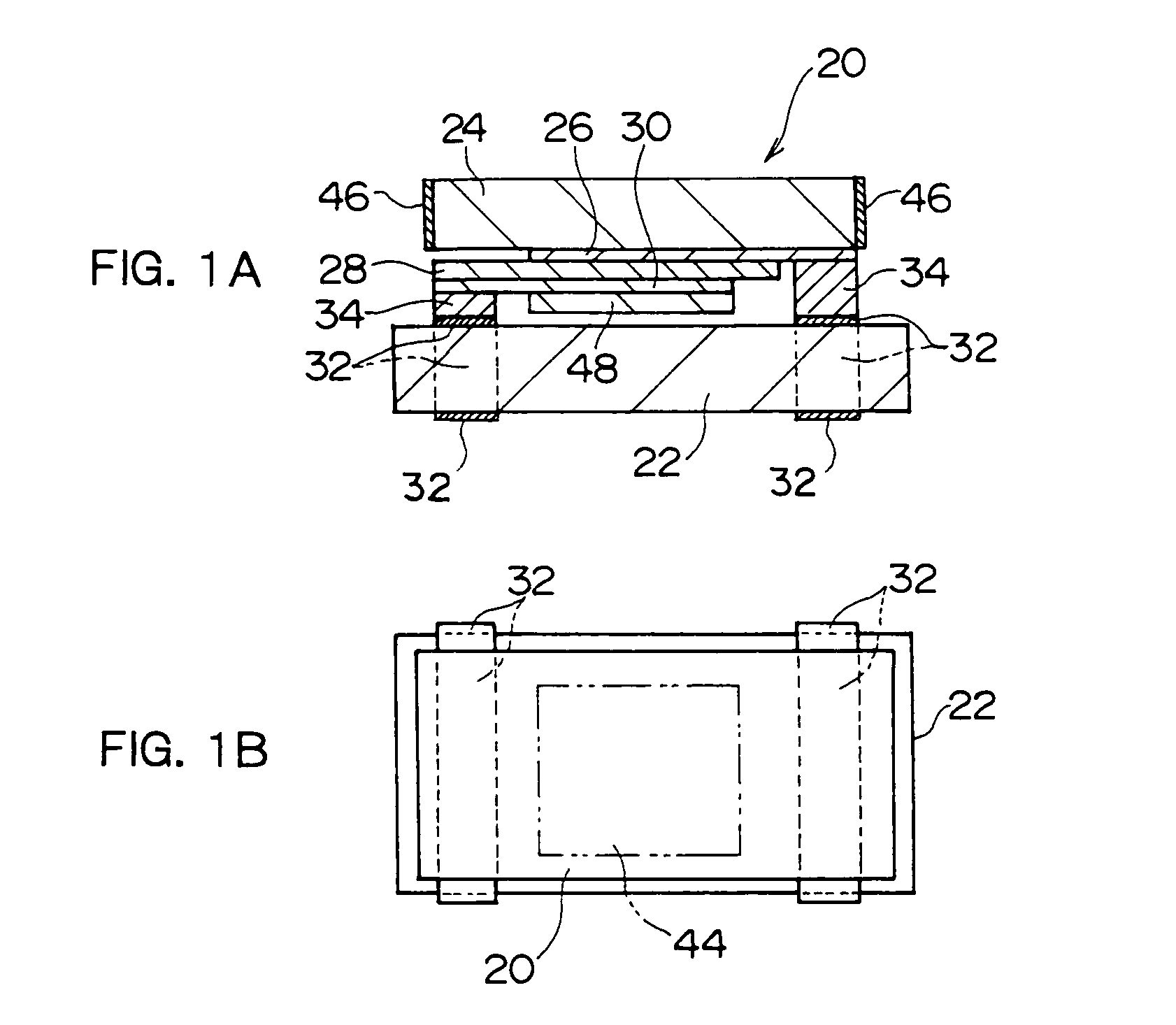Light detecting device and method for mounting the same
a technology for detecting devices and light receiving elements, applied in radiation controlled devices, optical radiation measurement, instruments, etc., can solve the problems that the surface mounting technique cannot be applied to the detecting device, and the surface mounting technique cannot be applied to the light receiving element, so as to prevent the incidence, the effect of effective surface mounting, and precise light detection
- Summary
- Abstract
- Description
- Claims
- Application Information
AI Technical Summary
Benefits of technology
Problems solved by technology
Method used
Image
Examples
example 1
[0090]A substrate in which a metal mask is used to sputter indium tin oxide (ITO) into a thickness of 1000 Å onto a cleaned 0.5 mm thickness borosilicate glass substrate (1.2×1.8 mm) [a transparent substrate 24 in which a transparent conductive electrode 26 is formed] is first put onto the substrate holder 3 set inside the vacuum container, and then the substrate is heated to 400° C. with the heater 4 after the container 1 is evacuated through the air outlet 2. N2 gas introduced at 2000 sccm through the gas introducing pipe 9 into the quartz pipe 5 having a diameter of 25 mm and 2.45 GHz microwaves set into an output of 250 W are supplied through the microwave guide 8 so as to be tuned for matching with a tuner. In this way, electric discharge is caused. At this time, the output of reflected waves is 0 W. H2 gas is introduced at 500 sccm through the gas introducing pipe 10 into the quartz pipe 6 having a diameter of 30 mm. The output of 13.56 MHz high-frequency waves is set into 100...
example 2
[0097]A black silicone resin (silicone adhesive KE 1831, manufactured by Shin-Etsu Chemical Co., Ltd.) is applied into a thickness of 10 μm onto a protective layer formed on a light receiving element, and further a thermosetting electrically conductive paste (an electrically conductive member 34) is dropped onto the respective electrodes (electrode portions for connection) of the light receiving element. While the positioning of the light receiving element is performed, the light receiving element is put onto the insulating substrate. The resultant is treated at 160° C. for 30 minutes to connect the terminal electrodes of the insulating substrate electrically to the respective electrodes of the light receiving element through the electrically conductive paste and further bond and fix the light receiving element onto the insulating substrate. Furthermore, a visible light absorbing layer 50 adhered closely to the protective layer is formed. In the same manner as in Example 1 except th...
example 3
[0100]The same silicone resin as in Example 1 is screen-printed on a light receiving element to form a protective layer of 10 μm thickness. Furthermore, the same silicone resin as in Example 2 is screen-printed on an insulating substrate to form a black visible light absorbing layer. In the same way as in Example 2 except that these are used, a light detecting device in which the protective layer is adhered closely to the visible light absorbing layer is produced. The spectral sensitivity of this light detecting device is not different from that of Example 2 in the ultraviolet ray range or the visible light range.
[0101]The terminal electrodes exposed to the end faces of the insulating substrate are mounted on creamy solder printed on an electric circuit board so as to position the produced light detecting device. The resultant is subjected to heat treatment at 250° C. for 30 seconds. As a result, the light detecting device is permitted to be surface-mounted onto the circuit board.
[0...
PUM
 Login to View More
Login to View More Abstract
Description
Claims
Application Information
 Login to View More
Login to View More - R&D
- Intellectual Property
- Life Sciences
- Materials
- Tech Scout
- Unparalleled Data Quality
- Higher Quality Content
- 60% Fewer Hallucinations
Browse by: Latest US Patents, China's latest patents, Technical Efficacy Thesaurus, Application Domain, Technology Topic, Popular Technical Reports.
© 2025 PatSnap. All rights reserved.Legal|Privacy policy|Modern Slavery Act Transparency Statement|Sitemap|About US| Contact US: help@patsnap.com



